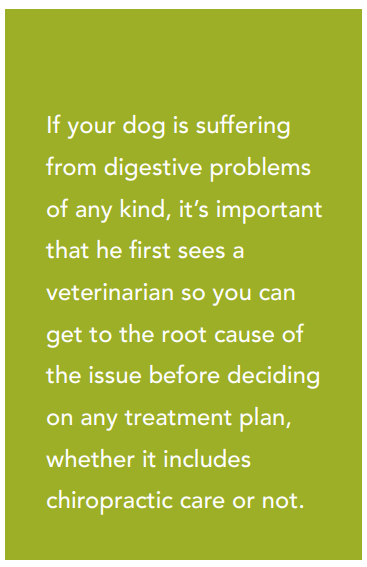How chiropractic care can help dogs with digestive problems

Chiropractic care isn’t just for back problems – it can also help relieve digestive problems in your canine companion.
Chiropractic care is geared at correcting musculoskeletal problems in humans, dogs, and other animals. Dogs with sore backs, as well as those that are unable to turn correctly, respond favorably to chiropractic care. But did you know that chiropractic can also help dogs with digestive problems? Let’s find out how.
The connection between muscles and the GI system
The GI system is comprised of smooth muscle that must contract appropriately to move ingesta through the digestive tract. This coordinated movement is orchestrated by the central nervous system, and is aided by the muscles of the back and abdomen. Poor coordination and improper communication between the brain and bowels lead to poor muscle tone and inappropriate movement, causing problems with digestion, which in turn leads to digestive problems.
The muscles of the abdomen and back are very important in supporting the organs of the GI tract and providing the abdominal press necessary for the proper expulsion that occurs during routine urination and defecation. Weak or sore back muscles will hinder your dog’s ability to properly squat for elimination, while weak or saggy abdominal muscles will hinder the abdominal press needed to to help move waste products towards the outside. Basically, most digestive upsets are caused by the inappropriate movement of waste through the GI tract.
How chiropractic works
Chiropractic care works well for musculoskeletal problems because it helps restore nerve flow to the target organ. When an area of the spine is not moving, it accumulates inflammation. The canine chiropractor finds areas of the spine that are not moving correctly and applies a specific force to restore movement, which aids in reducing inflammation in that area. This reduction of inflammation removes pressure from the nerves as they exit the spinal column. It has been proven that the weight of a feather on a nerve will decrease the rate at which impulses travel along that nerve by 50%! A decrease in communication between the brain and muscles results in improper function and weakening of the muscle, including those of the abdomen and back. “The quality of healing is directly proportional to the functional capability of the central nervous system to send and receive messages,” says Jason Edwards, MD.
Using chiropractic to help treat digestive upsets
Now that we can see how digestive upsets, muscle function, and communication from the brain are related, we can discuss adding chiropractic to the treatment plan for digestive issues. Chiropractic is a modality that allows the body’s own intelligence to aid in healing. This is the same intelligence that enabled two cells (the egg and sperm) to grow into the magnificent animal that is your dog. According to an article in the European Spine Journal, “Proper spinal function can help balance a key component of the body, the autonomic nervous system, which regulates many aspects of the health from blood pressure, heart rate, and breathing to gut function, sexual arousal and controlling stress.”
Your dog’s chiropractor should be certified by the American Veterinary Chiropractic Association (AVCA). In Canada, the Veterinary Chiropractic Learning Centre program is approved by the AVCA and the College of Animal Chiropractors. If your dog is having symptoms of an acute digestive problem, you may need to use some traditional treatments from your veterinarian along with a visit from your certified canine chiropractor.
 A canine chiropractor will examine and adjust your dog’s spine. Aligning his spine is the first line of defense in helping with digestive problems. In order to help him with chronic digestive problems, the chiropractor will also offer you suggestions for rehabilitating your dog to strengthen his abdominal muscles. Just as in humans, canine cross-training will help to build even strength and flexibility, including in the abdominal area. However, this muscle training can only be done once the signal from the brain is turned on via the chiropractic alignment. Think of it like reading a book in a dim room; it can be done with difficulty, but once you turn on the light it can be done much more easily and accurately. So too when it comes to correcting the muscles in and around your dog’s abdomen and digestive tract.
A canine chiropractor will examine and adjust your dog’s spine. Aligning his spine is the first line of defense in helping with digestive problems. In order to help him with chronic digestive problems, the chiropractor will also offer you suggestions for rehabilitating your dog to strengthen his abdominal muscles. Just as in humans, canine cross-training will help to build even strength and flexibility, including in the abdominal area. However, this muscle training can only be done once the signal from the brain is turned on via the chiropractic alignment. Think of it like reading a book in a dim room; it can be done with difficulty, but once you turn on the light it can be done much more easily and accurately. So too when it comes to correcting the muscles in and around your dog’s abdomen and digestive tract.
Note that this healing process may take time. The muscles of the abdomen and digestive tract didn’t become weak overnight, and they won’t become strong overnight either. In dogs recovering from an acute case or dealing with recurrent, chronic issues, a session with a certified animal chiropractor every couple of weeks will increase the rate of healing and aid in preventing more bouts of uncomfortable and sometimes serious digestive tract issues.




